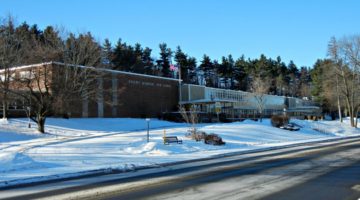The Worcester Tree Initiative and the Blackstone Headwaters Coalition distributed free trees to Main South residents on Wednesday.
WORCESTER – Since its inception in 2009, the Worcester Tree Initiative (WTI) has made plenty of arguments for its efforts to help replace the trees lost to the Asian longhorned beetle infestation.
They include aesthetics, shade, wildlife habitation and stress relief. Those were repeated Wednesday in the city’s Main South area, along with one other point of significance: water quality.
Wednesday, the WTI and representatives of the Blackstone Headwaters Coalition joined together on Claremont to help distribute trees and to teach residents how to plant them so that they live a long and healthy life.
The distribution is the final phase of a federal Environmental Protection Agency funded program that began in spring in both Main South and Quinsigamond Village. The goal, according to WTI’s Ruth Seward, was to replace trees that have been lost in areas of the city where it might be particularly hard to replace.
In all, 100 trees will be planted. One-hundred will be in the ground by mid-October, another 10 will be planted on Oread and Gardner streets in spring, after the Department of Public Works and Parks makes sidewalk cuts to accommodate the trees.
Peter Coffin, coordinator of the Blackstone Headwaters Coalition, said the program is a “win/win all around.”
Trees he noted, in addition to their better known benefits, also help protect water quality.
“It’s part of a more natural landscape,” Coffin said. “Water shouldn’t have to run off your property so fast. We should be trying to get that water into the ground.”
Trees are similar to detention ponds in that they capture water and filter pollutants, he said. What isn’t captured is slowed from overwhelming the city’s catch basin system, which ultimately leads to the city’s waterways or the treatment plant
Those waterways lead to the Blackstone River and, ultimately Narragansett Bay, said Donna Williams, also of the coalition.
“When we protect Worcester’s waterways by reducing storm water impacts, we are helping improve the Blackstone River and Narragansett Bay,” she said.
WTI’s Derek Lirange said there are multiple ways in which a tree reduces storm water flow, starting with the leaf canopies catch and hold water. Trees also absorb water through their bark and leaves, as well as roots.
In addition, the root system not only catches and absorbs water, but they also serve to loosen soil, making it more accepting of water. Typically, soil in a city is compacted and less impenetrable to water.
“The challenge is getting people to know we are here,” Coffin said of the tree-planting program.
Seward said much outreach has been done to get the word out, including door-knocking, networking with people involved in previous tree-planting programs and working through the city’s Community development corporations.
Main South Community Development Corporation member Dwight Morrison said the four trees he collected on Wednesday would go to private residences around the Main South area.
Among the Main South residents who had put in for trees were Greendale residents Tom Brown and David Johnston, who were involved in previous tree giveaways. They attended because they live in an area particularly affected by the beetle.
“We live between Burncoat West Boylston Street,” Brown said. “We lost practically all of our trees.”
One tree on his property was deemed beetle free, Brown said. But not long after he came home and the tree had been removed.
“I grew up in the tornado area,” he said. “All those trees were gone once, now they are gone again. Though, some of the trees have come back on their own, which is nice to see.”
Source: MassLive Worcester http://masslive.com/news/worcester




